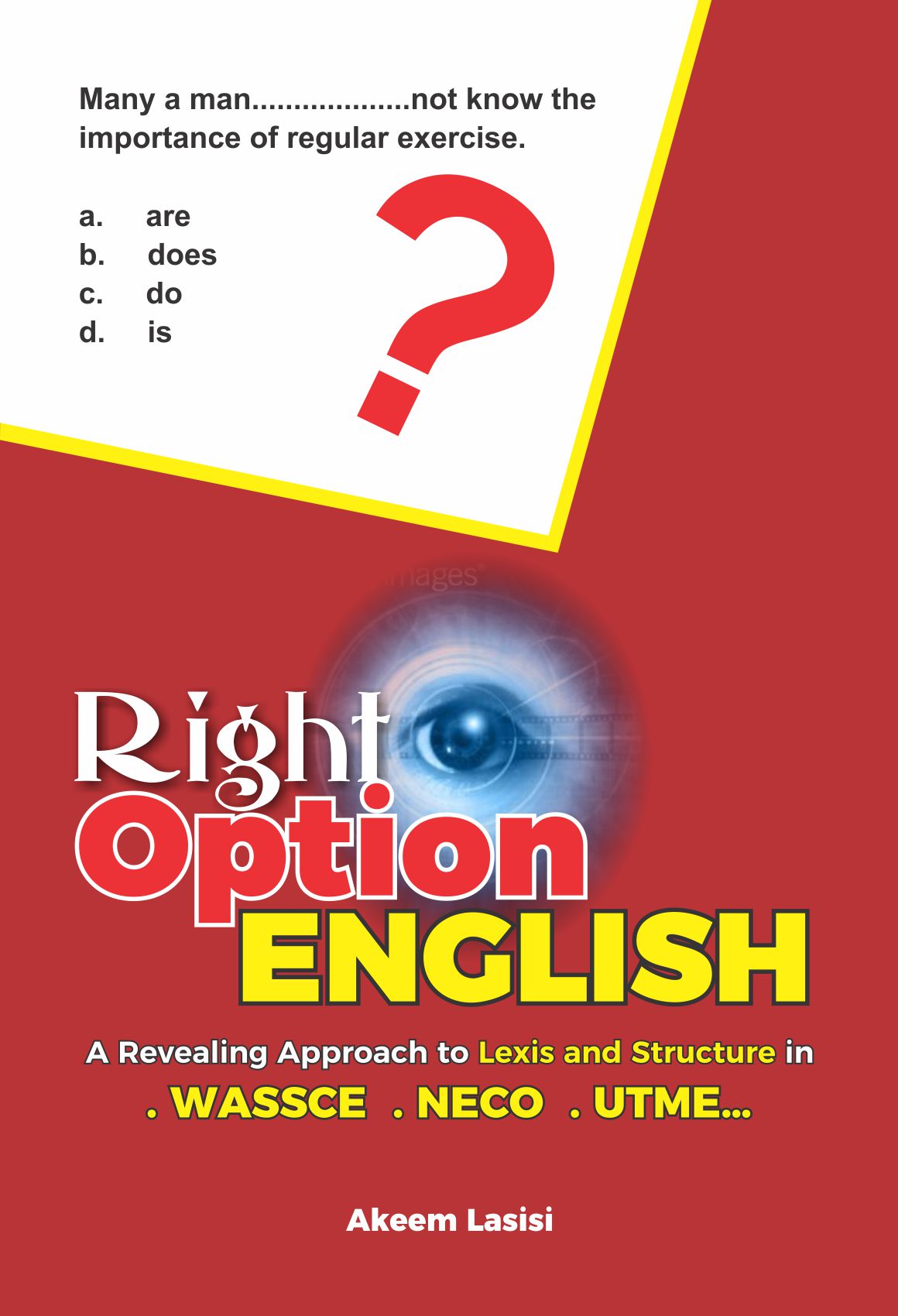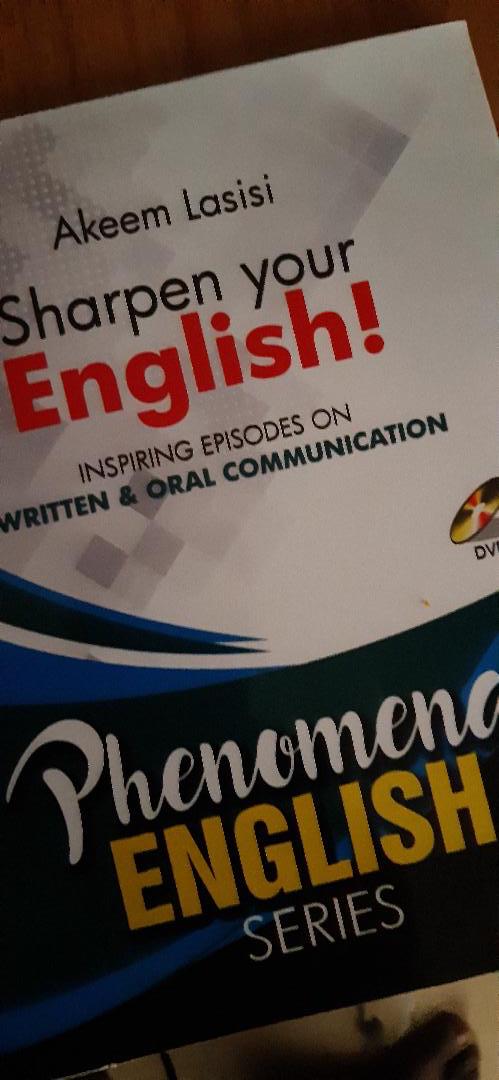By Akeem Lasisi
PRONOUNS are a large class of words in English. This perhaps explains why they attract more questions than some other parts of speech. Because pronouns have different forms and functions, many learners of English run into problems whenever handling them.
Equally important is the fact that some pronouns have the same form as some other word classes, and identifying them in relation to the functions they perform thus becomes a problem. The examiner is aware of this problem and, consequently, readily exploits it. Consider the following questions:
1. Between you and …, I think he took the money yesterday.
a. I
b. mine
c. me
d. my
2. A man who trains … to work hard every day will be
successful.
a. myself
b. himself
c. yourself
d. his self
3. I have forgotten … told me mat story.
a. whom
b. who
c. by whom
d. which
In Question 1, your knowledge of the use of objective and subjective pronouns is under test. In 2, reflexive/emphatic pronouns are being tested; while your knowledge of relative pronouns is being examined in 3. Let us categorise some questions on PRONOUNS, as they often appear in the WASSCE, NECO and UTME.
SUBJECTIVE vs. OBJECTIVE POSITIONS OF PERSONAL PRONOUNS
4. My sister and … were invited to the party.
a. myself
b. me
c. I
d. Mine
5. They gave the book to Akin and …
a. she
b. her
c. hers
d. herself
6. Let us rotate the leadership between you and …
a. me
b. I
c. myself
d. mine
To solve the problems above, you should bear in mind that while a noun can function as the SUBJECT or OBJECT of a clause without changing its form, PERSONAL PRONOUNS (I, he, she, it, we, they) do change forms as positions change.
SUBJECT VERB OBJECT
la. Akin Saw John
b. John Saw Akin
2a. I saw Akin
b. * Akin saw I (Wrong)
c. Akin saw me
Therefore, to get questions in the above category right, you have to remember that I, he, she, we, they are in the SUBJECTIVE case while me, him, her, us, and them are in the OBJECTIVE. However, ‘you’ and ‘it’ can function as SUBJECT and OBJECT without changing forms.
la. You saw Akin b. It saw Akin
2a. Akin saw you b. Akin saw it
But the clauses in questions 4 -6 are not as straightforward? Well, to some extent, you are right. For instance, you may note that it is not very easy to identify which words are the SUBJECTS or OBJECTS. In such situations, note that the elements on the right of the VERB are usually the SUBJECT, while those on the left are OBJECT. And, as we have in Question 4, we can have what we may call a COMPOUND SUBJECT: My sister and I. The break-down is:
My sister was invited to the party
I was invited to the party
Hence, me and the other two options are unfit. The right one is I:
My sister and I were invited to the party.
In 5, where there is ‘COMPOUND OBJECT’, we have:
They gave the book to Akin
and
They gave the book to her
Can we have ‘They gave the book to she’? Definitely no.
In the case of No.6, the battle is between me and I. But the conflict is resolved if you realise that it is the OBJECTIVE PRONOUN that isrequired: Between you and me. Note that it is the objective form of personal pronouns that follow between.
Consider the following:
Let us rotate the leadership between you and him
*Let us rotate the leadership between you and he (Wrong)
Let us rotate the leadership between you and me
*Let us rotate the leadership between you and I (Wrong)
Again, be very careful not to embrace pidgin-related constructions such as:
*Himself and Akin went there.
*She and myself cleaned the tables.
The correct equivalents are:
He and Akin went there.
She and I cleaned the tables.
However, note the use of ‘himself’ and ‘myself’ in the following:
He went there himself.
He hurt himself.
I cleaned the table myself.
I injured myself.
Lastly, note that for the reason of some form of linguistic courtesy, each of the rest of the PERSONAL PRONOUNS comes before THE FIRST PERSON PRONOUN I, when both are conjoined as the SUBJECT or OBJECT:
* I and she went there. (wrong)
She and I went there.
* I and you met them. (Wrong)
You and I met them.
The same is applicable to NOUNS and I:
* I and Akin met them. (Wrong)
Akin and I met them.
In the same vein:
They met me and Ade. (Wrong)
They met Ade and me.

EMPHATIC, REFLEXIVE OR RECIPROCAL?
7. He copied the note …
a. his self
b. herself
c. himself
d. by himself
8. Bode and Tunji are selfish; they care only about………….
a. each other
b. one another
c. themselves
d. theirselves
9. The two contestants eyed … cautiously.
a. one another
b. themselves
c. each other
d. one and other
10. The three girls have not been talking to … since they
quarrelled.
a. themselves
b. one another
c. one or other
d. each other
Without a good grasp of the different uses of the emphatic pronouns (myself, himself, herself, yourself ourselves and themselves), and the difference between these and the reciprocal (each other and one another), you are definitely in trouble with the questions above, the likes of which happen to be re-current in the examinations. Precisely, you should know that
EMPHATIC PRONOUNS emphasise the SUBJECT of the clause. Its function is somehow adjectival:
John cooked the soup himself.
I did the job myself.
They swept the house themselves.
Thus in Question 7, the correct answer is c because ‘himself ‘emphasises ‘he’:
He copied the note himself.
There is no word like hisself in English; herself goes with she; while by himself is wrong as ‘by’ is redundant in the structure.
REFLEXIVE PRONOUNS have exactly the same form as the EMPHATIC, as indicated above – myself, himself etc. But the words are said to be REFLEXIVE in a context where they are directly the OBJECTS of the clause:
S V O
I injured myself
Sade loves herself
They exposed themselves
Note that the REFLEXIVE can also follow a PREPOSITION:
He is talking to himself:
Compare:
S V O
She planted the corn herself. (EMPHATIC)
She injured herself. (REFLEXIVE)
Therefore, the correct answer for 8 is c: themselves:
They care only about themselves.
Another factor you should consider under the REFLEXIVE is that the components of the SUBJECT (when plural) jointly perform the action and equally collectively receive the results:
Ade and John enjoyed themselves
Ade and John disgraced themselves (when they attempted to steal a carton of beer at the party).
However, when the action is not collectively done by the components of the SUBJECT, when the time or motive of the action is different, the REFLEXIVE is no more correct:
*The two boys are abusing themselves.
This is why option B is wrong in No. 9, and A is wrong in 10.
*The two contestants eyed themselves cautiously.
*The three girls have not been talking to themselves since they
quarrelled.
The reason is that the actions expressed by the verbs are not only shared by the SUBJECTS, but are also exchanged between them. In such a context, we make use of the RECIPROCALS: each other and one another. Although the rule is relaxed now, when the action is exchanged between two SUBJECTS, we normally use each other as in:
She and the other girl accused each other of insincerity.
Ade and John are abusing each other.
Thus in question 9, since the first contestant is eyeing the second, and the second is equally eyeing the first (just two of them), the right option is C:
The two contestants are eyeing each other cautiously.
On the other hand, when three objects or more are involved, we use one another:
The two boys greeted each other.
The three boys greeted one another.
In this regard, the correct option for No. 10 is one another:
The three girls have not been talking to one another since they quarrelled.
NOTE: At times, the examiners include terms such as theirselves, themselfes, ourself, ourselfes, yourselfs, itselve, one and other among the options. All the items are absolutely wrong. They are only there to confuse you. Study questions 8 -10 again, taking into account the various senses expressed in the clauses. Also, firmly establish why one option is right and why others are wrong.

INDEFINITE PRONOUNS
If you have cared to study relevant past questions, you should be familiar with questions of this nature:
11. Each of the four men… a cutlass.
a. need
b. needs
c. need’s
d. is needing
12. Neither the teacher … the pupils knew what went wrong.
a. or
b. including
c. nor
d. and
13. The teacher sent for you and the other two boys, but…of
you was in the class.
a. both
b. each
c. neither
d. none
The above are examples of the various ways in which indefinite pronouns are tested. You should note that PRONOUNS in this category are numerous and they include each, either, one, both, someone, somebody, anyone, everyone, all, no one, neither, nor, none, nobody, some, many, few, little, much, many etc. To master the correct usage of each of these items, the factors of NUMBER, POLARITY and COLLOCATION have to be considered.
By NUMBER, we mean whether a particular indefinite pronoun is singular or plural. The singular indefinite pronouns are each, one, someone, either, everyone, anyone, neither, nobody and none. These SINGULAR INDEFINITE PRONOUNS take singular verbs:
Each has a pen.
* Each have a pen. (Wrong)
None requires a calculator.
*None require a calculator.
Somebody wants to see you.
* Somebody want to see you. (Wrong)
Option B is thus the right answer for question 11:
Each of the four men needs a cutlass.
Note that you don’t consider ‘the men’ in the context, because the SUBJECT (the HEAD WORD) is each, while ‘of the four men’ is just an ADJECTIVAL PHRASE modifying the HEAD. Similarly:
Neither of the men needs a cutlass
None of the men needs a cutlass
The plural pronouns are both, some, many, few as in:
Both are good.
Both is good. x
Few are good.
Few is good, x
Some of the indefinite pronouns can be singular in one context but plural in another. These are all, such, everybody.
All is not yet lost.
All the salt has been stolen.
All are to be punished.
Everybody has his or her cutlass.
Everybody have their cutlasses
NOTE: What the last example suggests is that in modern English, in order to avoid the clumsiness of using ‘his/her’ when both sexes are involved, it is acceptable to use ‘their’ as in the following:
As the snake made its way out of me fence, everybody was poised with their cutlasses.
Also:
Such is life.
Such is not allowed.
Such are the kinds of dresses he wants.
Such have been warned.
Such people have been warned.
By POLARITY, we mean whether an INDEFINITE PRONOUN indicates a negative or positive sense. Each, one, either, both, some, much, few, everybody, everything, anybody, anyone, something are all POSITIVE:
Either Ade or James came.
Each got a pen.
Much is still required.
On the other hand, neither… nor, none, nobody, nothing are negative.
Neither Ade nor John came.
None came.
By COLLOCATION, we mean the structural company that words keep. For instance, ‘neither’ and ‘nor’ normally work together to mean that each of the two objects being referred to is not suitable for, or does not perform, the indicated action. Hence, in question 68, the correct answer is ‘’nor:
Neither the teacher nor the pupils knew what was wrong.
Also, either and or keep a regular company:
Either Ade or Ahmed killed the chick.
Now, when you go back to question 69, you are likely to arrive at the field of contest between neither and none. What is the difference between the two? Although both suggest negativity, neither is used with two objects while none goes with three or more:
Neither of the two boys has arrived.
None of the three boys has arrived.
The correct answer for question 69 is, therefore, None.
POSSESSIVE PRONOUNS
In the case of possessive pronouns (mine, yours, his, hers, its, ours, theirs), objective pronouns might be brought into conflict with them as in him versus his. Also, note that the apostrophe is of no relevance to possessive pronouns, but examiners often play a card with it on unsuspecting candidates. Consider the following:.
14. The bag here is mine; but the luggage in the hallway is……….
a. theirs
b. theirs’
c. their’s
d. they
15. These are mine, others are…………………….
a. yours
b. your’s
c. yours’
d. you’s
16. That……………….was here this morning.
a. your own friend
b. friend’s of your’s
c. friend of yours
d. friend of yours’
17. This is her pencil.’…………….has been stolen.
a. His
b. He’s
c. His’
d. Him
The basic tip here is for you to master the correct forms of the possessive pronouns. Possessive pronouns and the personal pronouns they work with are:
I – mine
You – yours
He – his
She – hers
It – its
We – ours
They – theirs
It is very important to stress that none of the possessive pronouns takes an apostrophe. The common error is for a candidate to attach an apostrophe and s to mine (mine’s) or yours, his, her, its, ours and theirs. The apostrophe with sgoes with NOUNS:
This is my pen, Akin’s is there.
*This is my pen, your’s is there.
This is our book, the two boys’ are there.
*This is our book, theirs’ are there.
The analysis above accounts for why option A (theirs) is the right answer in question 14, and A (yours) is the right one in 15. It is B (friend of yours) in 16, and A (his) in 17.
In Question 17, another option that is grammatical (i.e. exists in English Language) is he’s. It is the contracted form of he is, as in:
He is around.
He’s around.
Just as you can have
They are around.
They’re around.
But He’sis not the correct option in 17 because what we need is the possessive. His:
His (pencil) has been stolen.
Consider
Leave him alone if………not ready to follow you.
a. his
b. his’
c. he’s
d. lies
The right answer is C.
Above all. always remember that the following items are ‘fake’: and unacceptable: his’ theirs’ your’s, ours, we’s etc. Don’t ever write or choose any of them as the correct answer.
18. He came to see………………….
a. a friend’s of his
b. a friend of his’
c. a friend of him
d. a friend of his
What is the correct answer here?
RELATIVE PRONOUNS
When relative pronouns are discussed, the issues of GENDER, FUNCTION and CONTEXT come in. But first, take a look at the
following.
19. I have forgotten………………told me that story.
a. whom
b. who
c. by whom
d. which
20. Benin,……………….is reputed to be a historical city, is the
capital of Edo State.
a. who
b. where
c. what
d. which
21. In……………….name was the cheque drawn?
a. whom
b. what
c. whose
d. who’s
22. In a situation ………..workers are underpaid, production is
bound to fall.
a. where
b. when
c. that
d. if
By GENDER, here, we do not mean that there is a particular relative pronoun used for a man and another one for a woman. For instance, who is used for both sexes. But there is a difference between the form used for human objects and the non-humans: who, whom, are normally for people while which is for non-humans:
1 a. The boy who came yesterday has left.
b. The girl to whom you were talking is my cousin.
2a. The cat which I bought last week is brown.
b. The spoon with which I stirred the soup is too long.
Therefore, when there is a conflict between who/whom and which, you primarily have to consider whether the object is human or not. This is why option D is inappropriate in No. 19, and why A is wrong in 20:
*I have forgotten which told me that story.
*Benin, who is reputed to be an historical city….
Further observation shows that the contexts in which RELATIVE PRONOUNS whoever, whichever, whatever are used can be traced to those of who, which, and what respectively:
3a. I know the man who took the pen.
b. Ask whoever took the pen to return it.
Thus, in 3 b, whichever or whatever are bad substitutes for whoever:
WHO OR WHOM?
Again, the following demonstrate the differences in the uses of who,
whom and whose. Who normally serves as subject in the clause where it
appears.
4a. The boy who slapped me has run away
b. The man who did not attend the meeting has apologised.
It further shows that WHO is normally followed by the VERB
(PHRASE) in such contexts.
On the contrary, WHOM is usually an object where it appears:
4c. The boy whom Ade slapped has run away.
d. The girl whom he told the story believes that it is true.
e. The man from whom I collected the book wants it now.
f. The man to/with whom I was talking is a tailor.
Note: In 4c above, whom is the object of the verb,’ slapped’, in the relative clause, ‘whom Ade slapped1.
Thus, while who is normally followed by a verb, whom is followed by a noun, pronoun or noun phrase.
The above analysis accounts for why option B is the right answer for No.
19:
I have forgotten who told me the story.
WHOSE
WHOSE indicates possession, and it is normally followed by a NOUN, or a NOUN preceded by an ADJECTIVE:
The man whose wife had run away appeared unruffled.
In whose house does James live?
The boy whose red pen you borrowed was looking for you.
Hence, the right answer for Question 21 is option C:
In whose name was the cheque drawn?
NOTE: Although whose collocates with both human and non-human objects, there is often a preference for the of-genitive (of which) with non-personal human antecedents:
a. The dog whose food was poisoned has died.
b. The book whose cover you tore is mine.
c. The house, the roof of which was blown off by the wind, belongs
to me.
Also, note that there is no English word like ‘whoose’. And the SUBJECTIVE who and which can be replaced with that, or left out completely as in 5f below:
5 a. The boy who came yesterday has left.
c. They boy that came yesterday has left.
d. The book which I bought is good.
e. The book that I bought is good.
f. The book I bought is good.
For Question 78, the right word is where, as it indicates a place; when would be right with ‘At a time …’, while thatand ifare completely unsuitable.
DEMONSTRATIVE PRONOUNS
They are this, that (singular); these, those (plural).
1. Consider whether or not the SUBJECT is singular or plural as the verb in the statement suggests:
This is very good.
These are very good.
2. Consider nearness in terms of whether the object of reference is close or distant to the speaker:
……………..are good while……….at the corner of the room is bad.
a. This / that
b. That/this
c. These/that
d. That/these
The correct answer for the question is c.
NOTE: The lesson is from Akeem Lasisi’s Right Option English textbook. Meanwhile, watch this short grammar video on pronouns and subscribe to Phenomenal English on YouTube for more:



